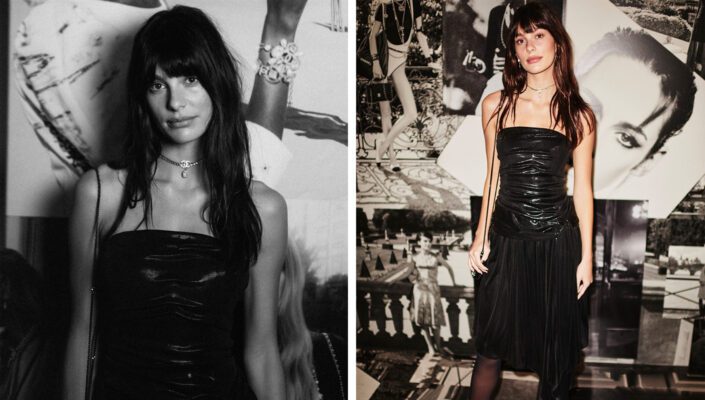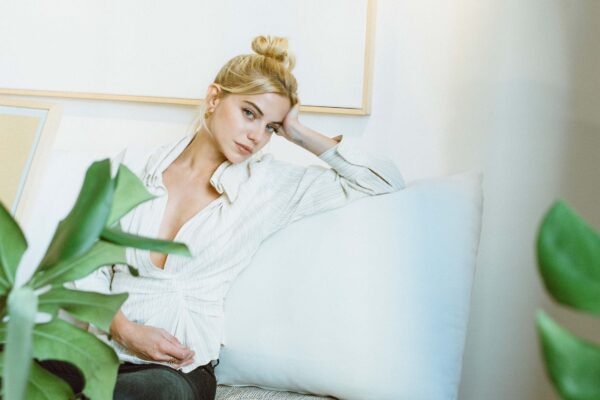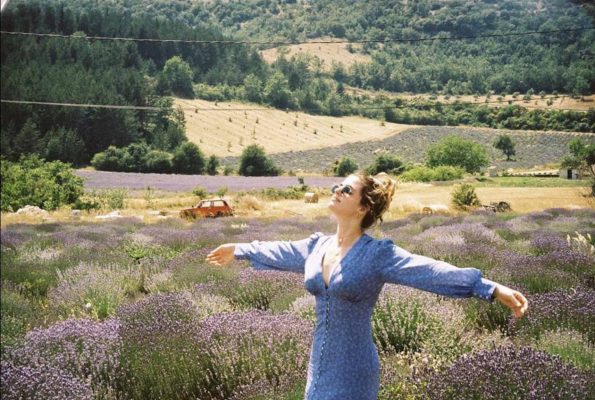
COFFEE WITH
MARIANA DI GIROLAMO: “YOU HAVE TO LET GO TO INCARNATE AGAIN”
Name: Mariana Di Girolamo
Profession: Actress
Nationality: Chilean
Zodiac Sign: Libra
Instagram: @marianadigirolamo
On May 2nd, CHANEL unveiled its Cruise Collection 2024/25 at the MAMO, Centre d’art de la Cité Radieuse in Marseille, France. Among the distinguished guests was Chilean actress Mariana de Girolamo. After the show, she sat down with us to discuss the motivations behind her work, the roles that inspire her and what informs her personal style.
LATINNESS: Mariana, we understand that you come from a family of artists; however, you initially chose to study medicine.
MARIANA: Yes, I studied obstetrics and childcare.
LATINNESS: So, if I had to give birth today, could you help me?
MARIANA: I don’t think so. In fact, it wouldn’t be very ethical to do so. I studied only a year and a half at the medical school of the University of Chile. When it was time to start practical training at the hospital, I realized I wasn’t happy. I couldn’t see a future for myself there, so I decided to leave and go back to studying, this time theater.
While I was in obstetrics school, I took a theater workshop, and during that time, we did “Las Grutas”, a play by the Chilean author Juan Radrigán. That experience made me feel alive. I enjoyed everything: reading the script, the costumes and the live performance.
This was not only special, but also decisive for me. I always loved to sing, and I come from a family of artists. My aunt Claudia Girolamo is a well-known actress in Chile. My parents are visual artists. That was the environment I grew up in, and ultimately, blood is thicker than water. I tried to go a different route, but my genes led me to the Theater School of the Catholic University.


LATINNESS: Nowadays, there is a lot of talk about “nepo babies”, but that was not the case with you?
MARIANA: You know what? They don’t use the term “nepo baby”; however, they frequently discuss it on social media. There’s a lot of hate. In my case, that hatred is also invisible because it’s not something people say to my face, but they make comments insinuating that I am where I am because of my last name (Di Girolamo), that I didn’t audition, that I got here through connections. In Chile, we call it “pitutado.”
At first, I’d go to interviews just to refute that. I was a scholarship student at the university, and I auditioned to get into television. I’m here on my own merit. I knew they would say it anyway, so I finally freed myself from it. “Let them talk, let the dogs bark.”
It’s not a burden for me; in truth, it’s an honor. I feel proud to be part of the Di Girolamo family legacy.
LATINNESS: What’s the most important skill an actor should learn?
MARIANA: I think one has to learn to let go of certain things. In my case, for example, scenes and moments. Actors are constantly moving and learning, portraying characters, and there comes a moment when it’s necessary to let go. You have to release in order to embody again, and that’s something that personally, I find very difficult, but it’s a great lesson.
LATINNESS: Your breakthrough was in the world of telenovelas in Chile. What differences exist between Mexican, Chilean, and Colombian telenovelas?
MARIANA: In Chile, we call them teleseries; in Argentina, tiras; and in Colombia, telenovelas. They are long-running fiction series. At the moment, I’m actually in one that has between 80 and 100 episodes. They are lengthy fictions, but in Chile, they are aired at different times. Afternoon ones are more melodramatic, the ones at 8 PM are family-oriented, and the late-night ones are dramas that touch on other topics. The concept is quite broad and diverse. They generally focus on and cater to the Chilean family, who sit down, have tea, and eat avocado toast in front of the television, identifying with the characters and marveling at them. And indeed, it’s true that my career started there: on television.


LATINNESS: Sometimes it’s the opposite: many actors start in cinema and later end up in telenovelas. In 2019, however, you ventured into cinema with none other than Pablo Larraín, starring in Emma. How does the world of telenovelas differ from making cinema? How do you prepare for a role?
MARIANA: It’s very different. I was filming a telenovela called Perdona nuestros pecados, a very successful nighttime drama in those years, and Pablo called me to film Emma. I was fortunate enough to both do the movie and finish the telenovela.
Another difference is that in telenovelas, you shoot with three cameras, which are generally fixed. So, going from theater school to television was one world, and then learning how television is made and then moving on to cinema was another. I mean, filming with a single camera using equipment like the Steadicam, the dolly… The language is also different because in cinema, EVERYTHING means something; every gesture and every suggestion counts, tells a story. Television is much more grandiose.
For me, it was super challenging to switch from one format to another. Now I’m back on television, so I had to reset quickly. Thankfully, having good colleagues, directors, and directors has helped me along the way. That’s very important.
LATINNESS: In Emma you portray a fantastic reggaeton dancer. Have you always enjoyed dancing?
MARIANA: I enjoy dancing, and I like reggaeton, although some people hate it. I’m from the Daddy Yankee generation, so my first concerts and parties were with Don Omar, Duelo de Maestro, and Wisin y Yandel.
LATINNESS: I’m from the same generation…We can party tonight!
MARIANA: I want to dance; in fact, I was telling the girls how great it would be to dance tonight… Hopefully we can. But yes, I played a reggaeton dancer in Valparaíso, a pyromaniac, a mother. Emma is a very powerful woman.


LATINNESS: You must go to a lot of auditions. What makes a role interesting for you these days?
MARIANA: It’s true, I have a lot of auditions. It’s tough. What I enjoy the most is facing in-person auditions, and that has been lost. Well, actually, we’re fortunate to be able to audition for roles in other parts of the world through Zoom or self-tapes.
However, I love the experience of learning a script, arriving in my costume, and performing it live. I’m interested in challenging roles. For example, I’ve thought about taking on a comedic role, perhaps dark comedy. I also want to sing— I’d like to do a musical audiovisual film.
Despite having a very diverse career, and I’m grateful for that, I’d like to step away a little from the mother roles I’ve been playing lately.
LATINNESS: At your young age, you’re one of the most renowned artists in Chile. How do you stay grounded and take care of your mental health?
MARIANA: That’s a really good question. I have a close and powerful circle in my nuclear family. However, one piece of advice I could give to someone working in the industry is to forge good friendships and dedicate time to them.
I don’t have many friends, but very good ones and they take care of me. My family does too, and they also remind me of who I am, where I come from, what my values and roots are.
That was one of the reasons I decided to return to Santiago and build a base from there to depart and return to. Through all these travels and experiences, I’ve discovered that it’s very important for me to be in my place and dream and migrate from there. I need a base.
LATINNESS: Grounded.
MARIANA: Yes, grounded to seek temperance and coherence, which is my goal for this 2024.
LATINNESS: What projects are you currently working on?
MARIANA: I’ve returned to television. I’m working on a series for Netflix and a free-to-air channel called MegaVision in Santiago.
It’s an 8 PM series called Al sur del corazón, which I’ve been filming for four months and still have a little while left. Also, I’m waiting for the release of a film I shot in Argentina. We’ll see which festival it premieres at. As you know, after acting, the production process begins.
I’m also going to work on another project in Argentina. This country has been a beautiful and very important window for me. I’ve worked a lot there and met some wonderful people. In fact, after finishing this series, I’ll be filming a three-episode miniseries.


LATINNESS: Besides cinema, you have a lovely connection with fashion. Where does it come from, and how would you describe your personal style?
MARIANA: I’ve loved fashion since I was little. We are four siblings (three girls), and we used to get hand-me-downs from our cousins. That’s where it all began.
During that time, I had to be very resourceful with clothes, mix and match, borrow a piece from my mother, another from that hand-me-down stash, and go to vintage stores. I’ve always played a lot with clothing.
Later, when I studied theater, I would go to the ”persa” to buy costumes.
LATINNESS: What is the “persa”?
MARIANA: Persa Biobío is a giant flea market, located in the Franklin neighborhood in Santiago. They sell many used, vintage items, including furniture and clothes. And there was a specific place called “El Baúl de la Tere,” where an older woman sold clothes from the 1920s to the 1980s. You could find great treasures there, and we always went to look for costumes for the theater school.
LATINNESS: Is it still open?
MARIANA: I’m not sure if “El Baúl de la Tere” is still open. The market is, though. She had the best treasures. I also remember the theater school’s trunk.
LATINNESS: I love knowing that you were so resourceful. I also had a very stylish aunt who sent me black bags filled with clothes for many years, and they were the greatest treasure for me. Nowadays, I try to do the same with my younger cousins.
MARIANA: Besides, I find it very enjoyable… a new life. And they are very noble garments, which is why they have endured over time. The greatest pleasure for me is going to a vintage store and finding treasures.
LATINNESS: You’re no stranger to cameras or red carpets. Today, we’re at the Chanel fashion show in Marseille. What can you tell us about your personal experience?
MARIANA: It’s been incredible and a beautiful experience. It’s my first time at a fashion show. I attended one in Spain a long time ago.
I was lucky enough to arrive two days early, explore the city a bit, which is incredibly beautiful, diverse, eclectic, vibrant, and full of art.
I loved every floral arrangement, every moment of the event. Also, the food and the Marseille Tarot reading that Chanel arranged for us.


LATINNESS: You know Alejandro Jodorowsky is a big defender of the Marseille Tarot. I’m reading a bit about Alejandro’s relationship with tarot and specifically the Marseille Tarot…
MARIANA: Yes, very interesting. The experience we had yesterday during the reading was lovely. I took a lot from the meaning of the High Priestess card and Temperance. I think I was able to bring that concept to the fashion show.
LATINNESS: Did any of the looks from the Chanel Cruise collection resonate with your personal style?
MARIANA: Oh, yes. There were three looks that I really liked, although overall, I found the entire collection very powerful.
It was a very immersive experience: the place we were in, the architecture… Many looks were quite structural and architectural. I’m not sure if they were inspired by the building we were in, but it was special to be on a rooftop, with the wind, the seagulls, the somewhat industrial electronic music. I felt the experience was very powerful.
I really liked the look worn by Sara, the Chilean model. It was a kind of asymmetrical poncho coat, very beautiful. Also, the white dress with the cape… Spectacular! And a set with beige macramé shorts with a kind of top. I don’t know if you saw it… golden with some details. Very powerful.
LATINNESS: What do you love most about Latin and Chilean culture?
MARIANA: I love our flavor, our quickness, and our cheekiness… The double entendre.


LATINNESS: Could you guide us through what a day in your life looks like when you’re filming?
MARIANA: Sure. I wake up at my house; I live in a neighborhood called Ñuñoa. I’ve had the house for a short time. I sleep with my dog and my partner.
I’m the first one to wake up the family. Then Vito, Vittorio, my little dog, wakes up. My baby, basically.
During that wake-up, there’s always a little coffee (I’m a big fan of coffee, I need it, and I really like it). Then, breakfast and shower. I choose my clothes on the same day. After that, I grab my car or sometimes, when I feel very tired, I take a taxi to the television channel where I’m working, which is about a 15-minute drive from my house.
Once there, the process of hair, makeup, and wardrobe begins. I meet up with my colleagues, go over the lines, and then head to the set to film.
Finally, back home. The time varies a lot, but generally, I finish between 6:30 and 7:30 in the evening. I film for an average of about eleven hours. When I get home, I spend time with my partner and walk the dog. Lately, I’ve been enjoying home life a lot, the personal space we’re creating with my family.
Images courtesy of Mariana Di Girolamo and CHANEL.



